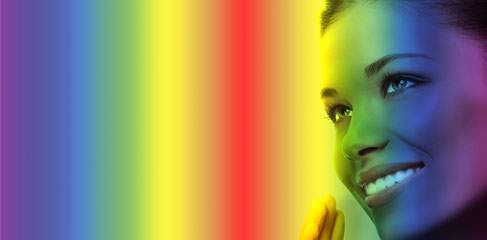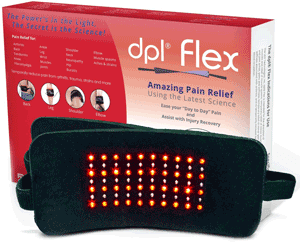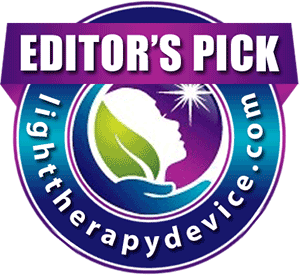Light is considered a type of electromagnetic radiation or EMR. Living and non-living entities absorb, emit or reflect electromagnetic radiation. The frequency spectrum spans from the short wavelengths of gamma rays to the long wavelengths of radio waves. Light wavelengths lie in the middle of the frequency spectrum. Visible light runs the gamut of between 400 and 700 nanometers or nm. Sir Isaac Newton developed the mnemonic Roy G Biv to represent red, orange, yellow, green, blue and violet visible light wavelengths. Red is at the high end of the spectrum with a wavelength of 700 nm while ultraviolet light has a frequency of 400 nm.
The health benefits correlating to light exposure were known since ancient Asian, Greek and Roman times. Currently, it is well known that the body must be exposed to direct sunlight in order to produce vitamin D. However, advances in science have discovered and gained a better understanding of how different wavelengths of the light spectrum provide specific benefits.

Table of Contents
History of Light Therapy
A researcher by the name of Neils Finsen from Copenhagen studied the effects of visible light on the skin and published his findings in 1893. His investigation began with the effects of artificial and direct sunlight on amphibians and insects. He suspected that light harbored beneficial health effects.
Finsen’s studies ventured into light wavelengths and which areas of the spectrum might boost healing properties. Of the many medical conditions that the physician endeavored to treat, he was particularly interested in the type of light that might help reverse the symptoms of the skin condition lupus vulgaris. By 1895, he was treating patients using two-hour sessions of ultraviolet light. The light featured a special filter and lens that produced the short wavelength that enabled the light to pass deep into the skin. That same year, Finsen established the Finsen Institute for Phototherapy and continued his research of light therapy. During his time at the institute, Finsen treated approximately 800 lupus patients. Half of the patients he treated were permanently cured.
Four decades ago, NASA began studying the effects of red light therapy on cell repair and plant growth. The technique proved useful for helping astronauts heal while in space and away from conventional medical treatment. The organization continues studying the beneficial effects of artificial light on skin conditions using different light wavelengths. Discoveries lead to the use of LED light technology used for many topical and internal conditions.
White Light Therapy
White light or morning dawn therapy involves sitting within two feet from a self-contained box that houses a white light, which emits an intensity of up to 10,000 lux. The white light contains all the colors of the spectrum and the intensity is deemed as being 100 times brighter than typical indoor light. The light box needs to be positioned at a 10:00 or 2:00 location in relation to the individual using the technique as treatment. Depending on the condition, treatment sessions take place first thing in the morning and last for 30 to 60 minutes. Boxes emitting less light intensity require longer treatment sessions. The individual cannot look directly at the light, but the light must be able to enter the eyes. While undergoing the hands-free box light therapy, individuals can read, watch TV or work on a computer.
The cones and rods in the retina enable us to distinguish the difference between different colors of light. When the light enters the eyes, the rays stimulate the cone and rod photoreceptors in the retina, which convert the light into electrical impulses. The impulses travel along the nerve pathways to the brain and stimulate the suprachiasmatic nucleus of the hypothalamus, the pineal gland and the pituitary gland. The pineal gland responds by decreasing melatonin levels. Blood circulation improves, which increases cellular oxygen and nutrient levels. Metabolism and energy levels also increase. When the endocrine system is stimulated, various body systems are affected by the release of hormones that inhibit depression.
The mechanism is then useful for rebooting the circadian rhythms to normalize wake and sleep patterns. Light therapy of this intensity is thus designed to mimic the effects of being exposed to sunlight. White light therapy has improved the lives of people experiencing a number of circumstances.
- Shift Workers – People who work night shifts typically sleep during the day, which disrupts the circadian rhythm due to a lack of sunlight exposure. Lightbox therapy is useful for regulating sleep/wake schedules.
- Jet Lag – When traveling between many different times zones, sleep/wake schedules are disrupted due to the changes in time. The body has difficulty differentiating between night and day. White light therapy helps habitual travelers regulate their circadian rhythms.
- Seasonal Affective Disorder-As the winter months approach, there are fewer hours of sunlight, which wreaks havoc with circadian rhythms and causes depression in some people. Studies indicate that approximately five percent of people diagnosed with the problem have a protein that removes the neurotransmitter serotonin out of the synapses between neurons, which leads to depression. The lack of sunshine exposure additionally causes an overproduction of melatonin from the pineal gland during the winter months, which leads to unusual fatigue and drowsiness. Some people experience symptomatic relief by taking antidepressants. However, studies demonstrate that white light therapy often corrects the disorder. Patients who knowingly have the disorder begin light therapy in the fall and continue treatment into the spring. However, therapy sessions can be adjusted depending on where one lives and how much sunshine a geographical location receives.
- Non-seasonal Depression-A study in Canada evaluated the effects of white light therapy on individuals suffering from depression that is not related to seasonal changes. Some of the test subjects underwent light box therapy alone. Others received an antidepressant plus light box therapy and a third group received a placebo. The individuals in the first two groups experienced symptomatic improvement compared to the last group that did not experience changes in condition. To the benefit of depression patients, white light therapy does not have the long list of horrendous side effects that often accompany antidepressant medications.
- Alzheimer’s Disease and Related Dementia-Scientists from the Netherlands Institute for Brain Research found the shrinkage that occurs in the hypothalamic region in adults aged 80 to 100 was likely the reason why seniors and individuals having Alzheimer’s and related dementia or ADRD suffer from sleep disorders. Trials involving exposing cognitively impaired seniors to bright light therapy improved sleep schedules, enhanced daytime alertness and reduced the symptoms of sundowners syndrome that is often seen in the afternoon. The elderly adults were exposed to a lux intensity ranging from 1,000 to 10,000 once to several times daily depending on individual symptoms, degrees of circadian rhythm disruptions and levels of agitation.
Possible Side Effects
Individuals undergoing regular white light therapy may experience:
- Agitation or irritability
- Eyestrain
- Headaches
- Nausea
However, many report the symptoms eventually subside. White light or light box therapy is contraindicated in people living with bipolar disorder, as the treatment has the potential to trigger manic episodes. Morning dawn therapy is also not recommended for diabetics who are at a higher risk of suffering from macular degeneration or retinal damage.
Blue Light Therapy
The blue light spectrum spans from 440 to 500 nm. In 2001, a group of scientists discovered that that ganglion cells in eyes are encompassed with chemical compounds called melanopsin, which is activated by blue light. Blue light at wavelengths of between 446 and 477 nm have been found to suppress melatonin hormone production in the pineal gland, which is necessary to ready the body for sleep. The study took place in the homes of the volunteer subjects and at the Assuta Sleep Laboratory. The participants were to maintain a sleep diary and complete a questionnaire concerning their sleep habits. While at the laboratory, the individuals were exposed to computer screens for two hours each night. The researchers found that the light emitted from the screens interfered with sleep. Blue light also heightens cognitive attention, hastens reaction time and improves mood.
The studies indicate that blue light exposure is thus effective in some people for treating:
- Jet lag
- Shift work
- Seasonal affective disorder
Blue light is also found in overhead lights, in specially manufactured lamps and light panels.
Blue phototherapy spanning the wavelengths of 405 nm through 470 nm has the ability to kill gram-negative and gram-positive bacteria according to various studies. When combined with photodynamic medications, which are light sensitive, blue light therapy is used to treat a number of topical conditions. The light wavelengths in the blue range are absorbed by the skin into a chemical substance produced by microbes known as Protoporphyrin IX. Once absorbed, the substance reacts with oxygen, inhibits cellular metabolism and destroys bacteria and fungi.
Treatment sessions last anywhere between 15 to 90 minutes. The time needed for therapy depends on the type of condition being treated, the size of the area requiring treatment and if phototherapy is used in conjunction with topical medications.
- Acne – Blue light therapy has the ability to eliminate the bacterial infections that contribute to the skin condition. Treatments also improve skin texture while reducing the activity of oil glands. Ongoing therapy additionally has the potential to minimize acne scars and eliminate sun spots.
- Sun Damage-Blue light treatments are beneficial for treating sun damaged skin, pre-malignant and malignant skin growths that have not metastasized.
Phototherapy Side Effects
The skin exposed to blue light treatments commonly turns red and may exhibit mild bruising, blistering, swelling and tenderness. The site then crusts and peels. Healing typically occurs within one to two weeks. Treatments are not recommended for patients having the blood disorder known as porphyria or systemic cancer. Protective eye goggles must be worn to prevent possible damage by looking directly at the blue light.
Green Light Therapy
The range of green light used for therapy ranges between 515 and 525 nm. Studies indicate that green light has been shown to be an effective means of pain treatment. Green light enters the eyes and stimulates the thalamus and other regions of the brain that releases endorphins, which are the body’s natural pain relievers. Although further research is needed, scientists theorize that green light might also reduce inflammation and swelling along the neural pathways of the central nervous system.
A scientist from the University of Arizona was inspired to study the effects of green light when a sibling reported that he experienced pain relief when visiting forested areas. The researcher accompanied by a group of scientists from the U of A investigated the potential therapy by exposing laboratory animals living with chronic pain to green lights for eight hours each day. Another group of animals was exposed to common room light. The animals seeing green light demonstrated symptomatic relief. The researchers theorized that green light may be especially beneficial for patients suffering from fibromyalgia and other forms of chronic pain.
Researchers from Boston studied the possible beneficial effects green light had on 69 patients suffering from migraine headaches. The volunteers were exposed to various light spectrums. Green light proved the most promising for pain management. In some instances, pain relief improved by up to 20 percent.
Red and Near Infrared Light Therapy
The red light spectrum runs from 620 to 700 nm. From there, invisible near-infrared and infrared light goes from 701 to 830 nm. At these wavelengths, the light has the ability to penetrate up to 10 millimeters through the skin and into deep tissues. Once the light is absorbed into the tissues, it affects cells on a molecular level. Red to infrared light stimulates cellular mitochondria to increase ATP or energy production, which quickens cellular activity to include reproduction and growth. When absorbed by blood and lymph vessels, the light stimulates the release of nitric oxide that causes vascular relaxation and dilation to improve blood and lymph circulation. In this way, cells and tissues receive an increase in much-needed oxygen and nutrients, which hastens the healing process.
Red light therapy or photobiomodulation therapy offers a number of rejuvenating and healing effects. The non-invasive treatments do not burn the skin or the tissues it contacts and produces very little heat. Depending on the type of condition being treated, sessions are typically scheduled for two or three times a week over a four to six week period. Each session lasts up to 20 minutes. Minimal side effects include a skin drying, slight reddening and possibly swelling of the treatment area, which dissipates in a matter of hours. So, unlike more dramatic cosmetic procedures, there is no need for recovery time.
Numerous studies performed around the world by researchers demonstrate that red, near infrared and infrared therapy:
- Stimulates the formation of new capillaries, which expands the blood circulation network
- Stimulates the production of collagen and fibrin to rejuvenate skin and repair connective tissues
- Promotes wound healing
- Reduces inflammation and swelling, which help reduce pain symptoms
- Interferes with the processes that cause oxidative stress and free radical damage that cause cell damage and death
- Reduces the appearance of fine lines and wrinkles
- Improves skin tone and texture
- Reverses hair loss
Although dermatological clinicians and salons offer red light therapy treatments, in-home devices are available that demonstrate positive results.
References
- “Niels Ryberg Finsen – Biographical”. Nobelprize.org. Nobel Media AB 2014. Web. 25 Mar 2018
- Science, Studies & Research, Body, Balance, System, March 25, 2018
- Even C1, Schröder CM, Friedman S, Rouillon F., “Efficacy of light therapy in nonseasonal depression: a systematic review.”, PubMed, March 24, 2018, October 22, 2007
- Yerevanian BI, Anderson JL, Grota LJ, Bray M., “Effects of bright incandescent light on seasonal and nonseasonal major depressive disorder.”, PubMed, March 24, 2018, August 18, 1986
- Praschak-Rieder N1, Willeit M, Neumeister A, Hilger E, Kasper S., [Therapeutic sleep deprivation and phototherapy]., PubMed, March 24, 2018, 1999
- Hanforda, N., Figueirob, M., “Light Therapy and Alzheimer’s Disease and Related Dementia: Past, Present, and Future,” PubMed, March 25, 2018, January 24, 2013
- Harrison, P., “Light Therapy Highly Effective for Major Depression,” Medscape, March 24, 2018, November 23, 2015
- The University of Haifa, “Blue light emitted by screens damages our sleep, study suggests,” Science Daily, March 24, 2018, August 22, 2017
- “Blue Light Phototherapy Has Potent Bacteria-Killing Ability,” Science 2.0, March 25, 2018, December 17, 2013
- Gotter, A., “Blue Light Therapy,” Healthline, March 25, 2018, August 4, 2017
- Tricoles, R., “Treatment of Pain Gets the Green Light,” University of Arizona News, March 25, 2018, March 1, 2017
- Preidt, R., “Giving the ‘Green Light’ to Migraine Relief,” WebMD, March 25, 2018, May 17, 2016
- Baez F., Reilly LR., “The use of light-emitting diode therapy in the treatment of photoaged skin.”, PubMed, March 25, 2018, September 6, 2007
- Na JI., Suh DH., “Red light phototherapy alone is effective for acne vulgaris: randomized, single-blinded clinical trial.”, PubMed, March 25, 2018, October 10, 2007
- Lee SY, Park KH., Choi JW., Kwon JK., Lee DR., Shin MS., Lee JS., You CE., Park MY., “A prospective, randomized, placebo-controlled, double-blinded, and split-face clinical study on LED phototherapy for skin rejuvenation: clinical, profilometric, histologic, ultrastructural, and biochemical evaluations and comparison of three different treatment settings.”, PubMed, March 25, 2018, July 27, 2007
- National Aeronautics and Space Administration, “NASA Light Technology Successfully Reduces Cancer Patients Painful Side Effects from Radiation and Chemotherapy,” March 25, 2018, March 3, 2011


